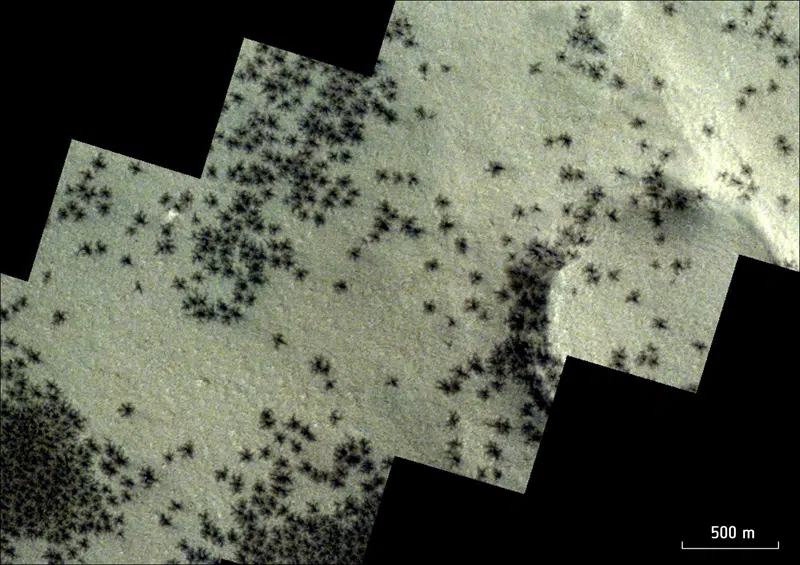
The European Space Agency’s Mars Express has snapped the telltale traces of ‘black spiders’ scattered across the southern polar region of Mars.
Rather than being actual spiders, these small, dark features form when spring sunshine falls on layers of carbon dioxide deposited over the dark winter months.
The sunlight causes carbon dioxide ice at the bottom of the layer to turn into gas, which subsequently builds up and breaks through slabs of overlying ice. The gas bursts free in Martian springtime, dragging dark material up to the surface as it goes and shattering layers of ice up to a meter thick.
The emerging gas, laden with dark dust, shoots up through cracks in the ice in the form of tall fountains or geysers, before falling back down and settling on the surface. This creates dark spots of between 45 m and 1 km across. This same process creates characteristic ‘spider-shaped’ patterns etched beneath the ice – and so these dark spots are a telltale sign that spiders may be lurking below.
Another of ESA’s Mars explorers, the ExoMars Trace Gas Orbiter (TGO), has imaged the spiders’ tendril-like patterns especially clearly. The spiders captured by TGO lie near, but outside, the region shown in this new Mars Express image.
The Mars Express view shows the dark spots on the surface formed by escaping gas and material, while the TGO perspective also captures the spidery, web-like channels that are carved into the ice below.
The aforementioned dark spots can be seen all over the Mars Express image, creeping across towering hills and expansive plateaus. However, most can be seen as small spots in the dark region to the left, which sits just at the outskirts of a part of Mars nicknamed Inca City.
The reason for this name is no mystery, with the linear, almost geometric network of ridges being reminiscent of Inca ruins. More formally known as Angustus Labyrinthus, Inca City was discovered in 1972 by NASA’s Mariner 9 probe.
“Black spiders” on Mars puzzled scientists
The dark streaks on Mars, resembling spiders, were first observed in images returned by NASA’s Mars Global Surveyor spacecraft in the early 2000s.
When scientists first observed the dark streaks on Mars, they were initially puzzled by their appearance and speculated about various possible explanations.
Some early hypotheses included the idea that the streaks might be formed by the flow of liquid water, which would have been significant as it could imply the presence of conditions conducive to life on Mars.
However, further analysis and observations revealed that the streaks were more likely related to seasonal processes involving carbon dioxide ice sublimation, rather than liquid water flows.
As scientists continued to study these features, they developed a better understanding of their formation mechanism, attributing them to the seasonal release of pressurized carbon dioxide gas beneath the Martian surface, which carries dark sand and dust and creates the spider-like patterns.
This interpretation has been supported by additional observations from various Mars orbiters and rovers, refining our understanding of the Martian surface processes.
Related: Will Future Colonists on the Moon and Mars Develop New Accents?
See all the latest news from Greece and the world at Greekreporter.com. Contact our newsroom to report an update or send your story, photos and videos. Follow GR on Google News and subscribe here to our daily email!



